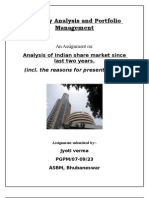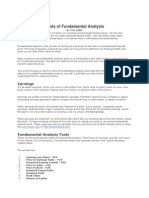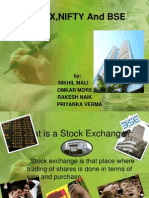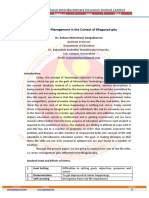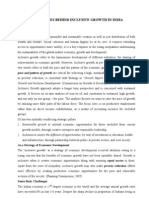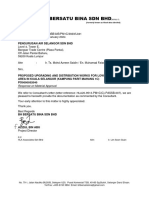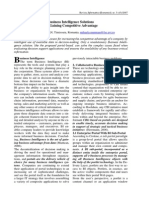Presented By:: Shubham Bhutada Aurangabad (MH)
Presented By:: Shubham Bhutada Aurangabad (MH)
Uploaded by
1986anuCopyright:
Available Formats
Presented By:: Shubham Bhutada Aurangabad (MH)
Presented By:: Shubham Bhutada Aurangabad (MH)
Uploaded by
1986anuOriginal Description:
Original Title
Copyright
Available Formats
Share this document
Did you find this document useful?
Is this content inappropriate?
Copyright:
Available Formats
Presented By:: Shubham Bhutada Aurangabad (MH)
Presented By:: Shubham Bhutada Aurangabad (MH)
Uploaded by
1986anuCopyright:
Available Formats
Presented By :
SHUBHAM BHUTADA
Aurangabad (MH)
INDEX
Definition of Stock and Stock market
Types Of Stock Exchange
Stock exchange in World and India
Trading In Stock Market
Demat Account
Importance Of Stock Market in stock trading
Investment in various types of trading
Stock Market Conditions
Calculations Of Indices
Benefits of Investing in shares
Causes Of Price Fluctuation
STOCK MARKET OR SHARE
MARKET
Stocks are issued by companies in order to raise capitals
and are bought by investors in order to acquire a portion
of the company.
A Stock market is the place where buying and selling of
stocks takes place. Nowadays due to internet and
advanced technology buying and selling of stocks takes
place anywhere in India and also from foreign country,
there is no need to be physical present in exchanges like
NSE and BSE. Stock markets are perfect competitive
market.
Types of Market
1. Normal Market :
Order Traded in regular lot Size
For demat shares, lot size is 1 share
2. Odd Lot Market :
Used for limited physical Market
Order not traded in regular lot Size but both price &
quantity should tally with each other.
3. Spot Market :
Different settlement periods depends on normal
orders
Sell & Purchases takes place on same date.
4. Auction Market :
Initiated by exchange on behalf of members
for settlement related reasons
Reasons are shortage and bad deliveries
Loss is recovered from members
Big Stock Markets
NYSE ( New York Stock Exchange)
NASDAQ-America
Dow Jones
S&P 500
Tokyo Stock Exchange
London Stock Exchange
Bombay Stock Exchange, India
National Stock Exchange, India
Stock Exchanges in India
There are 22 stock exchanges in India. But, two of them
are biggest.
NSE (National stock exchange) - is the 9th largest stock
exchange in the world by market capitalization and
largest in India by daily turnover and number of trades,
for both equities and derivative trading.
BSE (Bombay stock exchange) - is the oldest stock
exchange in Asia with a rich heritage of over 137 years
of existence.
Bombay Stock Exchange
Location: Mumbai
Index: Sensex (SENSitve indEX)
Consist of group of 30 Stock
Members: 852
Date of Launch: 03 January 1986
Base period:1978-79
Base Index Value:100
Sectoral indices
Timing: 09.30 AM 03.30 PM
Listed Co. : over 6000
National Stock
Exchange
Location: Mumbai
Index: Nifty (National Stock Exchange Fifty)
Consist of group of 50 Stocks
Date of Launch: April 1994
Base period: 1993-94
Base index value: 1000
Members 726
Stock Broker
A stockbroker is person who is licensed to trade
in shares.
Brokers also have direct access to the share
market and can act as your agent in share
transactions.
For this service they charge a fee i.e. brokerage.
They can also offer additional services like
advice on shares, debentures, government
bonds and listed property trusts and non-listed
investment options (cash management trusts,
property and equity trusts.
TRADING IN STOCK MARKET
The market regulator, the Securities and
Exchange Board of India (SEBI), has made it
compulsory to open the demat account if you
want to buy and sell stocks.
A person want to buy/sell stocks in the stock
market has to first place his/her order with a
broker or can do themselves using online trading
systems.
The stocks purchased will be sent to the your
demat account. This process is called Rolling
Settlement Cycle.
What is Demat account?
DEMAT stands for DEMATerialization. It is
process in which physical paper shares are
converted into paperless (computerized) form.
In India there are two Depository organizations
called NSDL (National Securities Depository
Ltd.) &CDSL (Central Depository Services India
Ltd.)
Brokers and most of Banks provides facility to
open demat account.
Important terms in stock market
and in stock trading
Open- The stock price in beginning of Day(i.e. in
morning).
High - The stock price reached at the highest level in
a day.
Low - The stock price reached the lowest level in a
day.
Important terms in stock market and
in stock trading
Close - The stock price at which it remains after the end
of market timings or the final price of the stock when
the market closes for a day.
Volume - Volume is nothing but quantity.
Bid - The Buying price is called as Bid price.
Offer - The selling price is called offer price.
Investment in Short term, Mid
term and Long term trading
Short Term Trading -
Stock trading done from one week to couple of
months is called short term.
Mid term Trading -
Stock trading done from one month to couple of
months, say six to eight months is called mid term
trading.
Investment in Short term, Mid
term and Long term trading
Long term trading -
Stock trading done form couple of months to
couple of years is called long term trading.
Companies whose fundamentals are good and have
good future plans then the stocks of these
companies are used for long term trading.
Generally traders having good capital go for long
term trading.
Stock Market Conditions
There are two ways to describe the general conditions of
the stock market:
1)BULL MARKET
2)BEAR MARKET
Bull Market -
A Bull Market indicates the constant upward movement of
the stock market. A particular stock that seems to be
increasing in value is described to be bullish.
Stock Market Conditions
BEAR MARKET
A bear market indicates the continuous downward
movement of the stock market. stock that seems to be
decreasing in value is described to be bearish.
How Sensex Index is calculated
The formula for calculating the sensex =
(sum of Free Float Market capitalization of 30 benchmark
stocks)* Index Factor
Where;
Index Factor = 100/market cap value in 1978-79.
Example on Sensex Index
calculation
Assume sensex has only 2 stocks namely SBI and
RELIANCE. Total shares in SBI are 500 out of 200 are
held by government and only 300 are available for
public trading. Reliance has 1000 shares out of which
500 are held by promoters and 500 are available for
trading. Assume price of SBI stock is Rs. 100 &
Reliance is RS. 200.
Example on sensex
calculation
Solution
Then Free Float Cap of these two company
= (300*100+500*200)
= 30,000+1,00,000
= 1,30,000
Assume market cap during the year 1978-79 was
25000
Then SENSEX = 1,30,000*100/25000
= 520
How Nifty Index is calculated
The National Stock Exchange (NSE) is
associated with Nifty
The calculation of Nifty is same as we
calculated SENSEX. But with two key
differences.
1. Base year is 1995 and base value is 1000
2. Nifty is calculation based on 50 stocks.
everything else remaining the same in nifty
index calculation as well.
Example of Nifty Calculation
Assuming Base index=1000 , Market Cap index consist
of 5 stocks, then
Company Current Market Base Market
Capitalisation (Rs. Capitalisation
In Lakhs) (Rs. In Lakhs)
Reliance 16,68,791.1 16,54,247.5
AB & U 8,72,686.3 8,60,018.25
INFOSYS 14,52,587.65 14,65,218.8
HLL 26,75,613.3 26,69,339.55
Tata Tea 6,60,887.75 6,62,559.3
Total 73,30,566.1 73,11,383.4
Cont..
Index= ( Current Market Capitalisation )
Base Market Capitalisation
Multiply by Base Value
Index= 73,30,566.1 *1000
73,11,383.4
Index= 1002.62
Important Indices in the world
Name of Country Weight No. Pf Base Base
Index Stock Year Value
S & P CNX NSEIL, Market Capitalisation 50 1995 1000
Nifty India
SENSEX 30 BSE, Market Capitalisation 30 1978-79 100
India
NASDAQ NASDAQ Market Capitalisation 100 1985 125
100 , USA
FTSE 100 UK Market Capitalisation 100 1984 1000
Hang Seng Hong Market Capitalisation 33 1964 100
Kong
Dow Jones USA Price 30 1928
Nikkei 225 Tokyo Price 225 1949
Benefits of investing in shares
Possibility of increase in
value of share
Income from dividends
Easy liquidity
Tax benefits on income
earned such as exemptions
U/s 10(34) for dividends,
Sec 54 for calculating STCG
& LTCG
CAUSES OF PRICE FLUCTUATION
1.DEMAND AND SUPPLY
2.BANK RATE
3.SPECULATIVE PRESSURE
4. ACTIONS OF UNDERWRITERS AND OTHER FINANCIAL
INSTITUTIONS
5.CHANGE IN COMPANYS BOARD OF DIRECTORS
Cont
6. FINANCIAL POSITION OF THE COMPANY
7. TRADE CYCLE
8. POLITICAL FACTORS
9. SYMPATHETIC FLUCTUATIONS
10. OTHER FACTORS:
A. EXPECTED MONSOON
B. PERSONAL HEALTH OF HEAD OF GOVERNMENT OR
CHAIRMAN OF THE COMPANY
C. OIL PRICES IN THE INTERNATIONAL
MARKET
You might also like
- 100 Specifications c15 and c18 CaterpillarDocument292 pages100 Specifications c15 and c18 CaterpillarBASILIO JARA HUERTA100% (7)
- Presentation On Stock MarketDocument25 pagesPresentation On Stock Marketsunil pancholi85% (47)
- Indian Stock Market PDFDocument14 pagesIndian Stock Market PDFDeepthi Thatha54% (13)
- Stock Market IndicesDocument47 pagesStock Market Indicessushantgawali67% (3)
- University of Mumbai: Student DeclarationDocument62 pagesUniversity of Mumbai: Student DeclarationRachana Sontakke0% (1)
- Introduction To Stock MarketDocument108 pagesIntroduction To Stock Marketsvmani100% (7)
- Component List: Relays: Service InformationDocument2 pagesComponent List: Relays: Service InformationAdmin TestNo ratings yet
- EngineDocument6 pagesEngineThắng Dương xuânNo ratings yet
- SensexDocument24 pagesSensexAmit MittalNo ratings yet
- Indian Stock Market: Market of "Hope, Discipline & Greed"Document40 pagesIndian Stock Market: Market of "Hope, Discipline & Greed"shavetamanikNo ratings yet
- Training Day-1 Stock MarketDocument33 pagesTraining Day-1 Stock MarketSiddheshwari SisodiaNo ratings yet
- Art of Stock Investing Indian Stock MarketDocument10 pagesArt of Stock Investing Indian Stock MarketUmesh Kamath80% (5)
- An Introduction To The Indian Stock MarketDocument7 pagesAn Introduction To The Indian Stock MarketsandystaysNo ratings yet
- Indian Stock MarketDocument100 pagesIndian Stock Marketankushsachdeva27No ratings yet
- The Indian Stock MarketDocument47 pagesThe Indian Stock MarketManvendra ChaudharyNo ratings yet
- Financial MarketsDocument54 pagesFinancial Marketsdurga_319No ratings yet
- Basics of Stock MarketDocument5 pagesBasics of Stock MarketArun KC50% (2)
- Indian Stock MarketDocument18 pagesIndian Stock Marketjyoti verma81% (27)
- Stock Market!!!!: First Step To Investing inDocument22 pagesStock Market!!!!: First Step To Investing insagar029No ratings yet
- Stock MarketDocument125 pagesStock MarketAman aggarwal100% (1)
- 17 A To Z of Stock Market WordsDocument14 pages17 A To Z of Stock Market Wordsyashlatha0% (1)
- Tools of Fundamental AnalysisDocument7 pagesTools of Fundamental Analysisdverma1227No ratings yet
- What Is Stock MarketDocument20 pagesWhat Is Stock MarketAgrawal Market GurukulNo ratings yet
- A Practical Handbook On Stock Market TradingDocument105 pagesA Practical Handbook On Stock Market TradingSudhanshu Singh100% (4)
- A Guide To Selecting Shares (EGuide)Document23 pagesA Guide To Selecting Shares (EGuide)Hermo Patacsil100% (1)
- Indian Stock MarketDocument91 pagesIndian Stock Marketsukhwindersinghsukhi70% (10)
- The Top Technical Indicators For Options Trading PART 2Document4 pagesThe Top Technical Indicators For Options Trading PART 2astro secretesNo ratings yet
- Penny Stocks To Hold For The Long-TermDocument6 pagesPenny Stocks To Hold For The Long-TermPGM5HNo ratings yet
- Presentation On Scam in Stock MarketDocument16 pagesPresentation On Scam in Stock Marketsachincool0100% (2)
- Stock Market Training CourseDocument13 pagesStock Market Training Coursev guptaNo ratings yet
- Zero Hero - Options Handbook (Nifty & Banknifty) - Marketman - 2023 - Anna's ArchiveDocument28 pagesZero Hero - Options Handbook (Nifty & Banknifty) - Marketman - 2023 - Anna's Archiveguy fawkesNo ratings yet
- Fundamental AnalysisDocument23 pagesFundamental AnalysisAdarsh Jain100% (1)
- What Is A Share or Stock?Document12 pagesWhat Is A Share or Stock?Vicky MbaNo ratings yet
- 15 Must Read Books On Investing, Stock Markets, & Trading - GrowwDocument9 pages15 Must Read Books On Investing, Stock Markets, & Trading - GrowwsumonNo ratings yet
- Stock ExchangeDocument43 pagesStock ExchangeGaurav JindalNo ratings yet
- Future & OptionsDocument27 pagesFuture & OptionsSameer100% (2)
- Stock MarketDocument69 pagesStock MarketKinnari SinghNo ratings yet
- Technical and Fundamental Analysis of Selected Securities of Indian Stock MarketDocument81 pagesTechnical and Fundamental Analysis of Selected Securities of Indian Stock MarketAbhijith V Ashok100% (1)
- Stock MarketDocument67 pagesStock MarketAbid faisal AhmedNo ratings yet
- How Do I Master Intraday TradingDocument3 pagesHow Do I Master Intraday TradingAnonymous w6TIxI0G8lNo ratings yet
- Working of Stock Market in IndiaDocument67 pagesWorking of Stock Market in IndiasunitgargNo ratings yet
- Project of Stock MarketDocument92 pagesProject of Stock MarketHARSH GAIKWADNo ratings yet
- Currency Derivatives Project - LavnishDocument64 pagesCurrency Derivatives Project - LavnishLavnish Jaitly60% (5)
- 15 Best ETFs in India To Invest in 2024Document27 pages15 Best ETFs in India To Invest in 2024Parasaram SrinivasNo ratings yet
- Basics of Stock Market-S1Document36 pagesBasics of Stock Market-S1shivam4822No ratings yet
- Stock Market: High Loss, High GainDocument11 pagesStock Market: High Loss, High GainGarv AgrawalNo ratings yet
- Fii Dii Activity - Participants Wise Oi AnalysisDocument15 pagesFii Dii Activity - Participants Wise Oi AnalysisNayagraNintyNo ratings yet
- Stock Market: Aditya Mohan BBA 3"B"Document11 pagesStock Market: Aditya Mohan BBA 3"B"rajivNo ratings yet
- Lecture 2 - Derivative Market: Futures Forwards OptionsDocument29 pagesLecture 2 - Derivative Market: Futures Forwards OptionsRubeenaNo ratings yet
- Technical Analysis of Stock MarketDocument42 pagesTechnical Analysis of Stock MarketSameer Shinde100% (1)
- Stock-Market-Basics 30715 PDFDocument27 pagesStock-Market-Basics 30715 PDFAdam Basrindu100% (2)
- Indian Stock MarketDocument71 pagesIndian Stock MarketNeha Thakur100% (1)
- An Over View of Indian Share Market: David Ashirvadam Sharekhan PVT LTDDocument31 pagesAn Over View of Indian Share Market: David Ashirvadam Sharekhan PVT LTDDavid Thambu100% (1)
- Stock MarketDocument55 pagesStock MarketKanwal Sachdev100% (1)
- Nse Bse OkDocument24 pagesNse Bse OkUrvashi SharmaNo ratings yet
- Indian Stock Exchanges and How Their Indices Are CalculatedDocument30 pagesIndian Stock Exchanges and How Their Indices Are CalculatedAapnijche FakeidNo ratings yet
- S & P, CNX, Nifty and Bse: By: Nikhil Mali Omkar More Rakesh Naik Priyanka VermaDocument24 pagesS & P, CNX, Nifty and Bse: By: Nikhil Mali Omkar More Rakesh Naik Priyanka VermaKishan SekhadaNo ratings yet
- Indian Stock Exchanges and How Their Indices Are CalculatedDocument30 pagesIndian Stock Exchanges and How Their Indices Are CalculatedKirron ThakurNo ratings yet
- Submitted by:-SUSHIL KUMAR Pujil Khanna Robin Choudhary Avinash JeswaniDocument22 pagesSubmitted by:-SUSHIL KUMAR Pujil Khanna Robin Choudhary Avinash Jeswanipujil2009No ratings yet
- Bombay Stock Exchange: by Soham Chhaya-Roll No 14Document32 pagesBombay Stock Exchange: by Soham Chhaya-Roll No 14Soham ChhayaNo ratings yet
- Index calculationDocument18 pagesIndex calculationnehasp1503No ratings yet
- X-Mas New Year: CelebrationsDocument11 pagesX-Mas New Year: Celebrations1986anuNo ratings yet
- Day4 Residential Status and Incidence of Tax (9 Oct)Document12 pagesDay4 Residential Status and Incidence of Tax (9 Oct)1986anuNo ratings yet
- Stress Management and GeetaDocument5 pagesStress Management and Geeta1986anuNo ratings yet
- Grade 1 IMO in PDFDocument11 pagesGrade 1 IMO in PDF1986anuNo ratings yet
- Stress Management in The Context of Bhagavad-Gita: Dr. Kallave Maheshwar GangadharraoDocument5 pagesStress Management in The Context of Bhagavad-Gita: Dr. Kallave Maheshwar Gangadharrao1986anuNo ratings yet
- (Book Chapter) Risk-Analysis-in-Capital-BudgetingDocument49 pages(Book Chapter) Risk-Analysis-in-Capital-Budgeting1986anu100% (2)
- Overhead - Machine Hour RateDocument17 pagesOverhead - Machine Hour Rate1986anu100% (1)
- 31st March Performance BudgetingDocument13 pages31st March Performance Budgeting1986anuNo ratings yet
- Self ManagementDocument22 pagesSelf Management1986anu83% (6)
- Foreign BanksDocument9 pagesForeign Banks1986anuNo ratings yet
- Sushil MundadaDocument20 pagesSushil Mundada1986anuNo ratings yet
- Venture CapitalDocument45 pagesVenture Capital1986anuNo ratings yet
- Advance TaxDocument2 pagesAdvance Tax1986anuNo ratings yet
- Public Sector BanksDocument1 pagePublic Sector Banks1986anuNo ratings yet
- Depository and Stock ExchangeDocument22 pagesDepository and Stock Exchange1986anuNo ratings yet
- Chapter - I Mutual Funds in IndiaDocument28 pagesChapter - I Mutual Funds in India1986anuNo ratings yet
- QuestionnaireDocument3 pagesQuestionnaire1986anuNo ratings yet
- Inclusive GrowthDocument8 pagesInclusive Growth1986anuNo ratings yet
- Jeffadd Additives: Performance ProductsDocument2 pagesJeffadd Additives: Performance ProductsPhuong The NguyenNo ratings yet
- Presidential Decree No. 851 Presidential Decree No. 851 "Decree"Document3 pagesPresidential Decree No. 851 Presidential Decree No. 851 "Decree"Marjorie MayordoNo ratings yet
- Jullianne's Catering and Events ServicesDocument16 pagesJullianne's Catering and Events Servicesmaria alpha sierra abiertasNo ratings yet
- Designing Combinational Logic Gates in CMOSDocument21 pagesDesigning Combinational Logic Gates in CMOSMonica MagnateNo ratings yet
- 23.12.23 - BBBSB - ais.PM1C.2023.L041 - Submission of Material Approval.Document45 pages23.12.23 - BBBSB - ais.PM1C.2023.L041 - Submission of Material Approval.Akmal ZaharinNo ratings yet
- Logcat Prev CSC LogDocument103 pagesLogcat Prev CSC LogChaabani BéchirNo ratings yet
- Don Tamil GuideDocument6 pagesDon Tamil Guidesivaarun200721No ratings yet
- India EV Landscape Charging Up The EV EcosystemDocument32 pagesIndia EV Landscape Charging Up The EV EcosystemJAY SHETH50% (2)
- FRCLM PDFDocument3 pagesFRCLM PDFMohan ShanmugamNo ratings yet
- Means of Embarkation and Disembarkation From Ships in Port: Marine Notice 13/2014Document4 pagesMeans of Embarkation and Disembarkation From Ships in Port: Marine Notice 13/2014fmitranoNo ratings yet
- S4000TH General Monitor Gas Detector Data SheetDocument2 pagesS4000TH General Monitor Gas Detector Data SheetmuthuNo ratings yet
- TOEIC® Test Speaking Questions 1 - 2: Quick GuideDocument45 pagesTOEIC® Test Speaking Questions 1 - 2: Quick GuideNam PhanNo ratings yet
- Bill To:: To, PG Students, Bangalore UniversityDocument1 pageBill To:: To, PG Students, Bangalore UniversityDEVARAJU K GNo ratings yet
- The Effect of Apple Cider Vinegar Dietary Supplement On The Activity of Rumen Infusoria of Dairy CowsDocument12 pagesThe Effect of Apple Cider Vinegar Dietary Supplement On The Activity of Rumen Infusoria of Dairy CowsVladimir Gurjanov100% (1)
- Essentials of Sheet Metal Work and Pattern Drafting 1918Document190 pagesEssentials of Sheet Metal Work and Pattern Drafting 1918Jogin100% (2)
- Application For NDT Ut Node/Nozzle EndoresmentDocument7 pagesApplication For NDT Ut Node/Nozzle EndoresmentIqfal ZulhendriNo ratings yet
- Brochure Doosan GV222TIDocument4 pagesBrochure Doosan GV222TIGabriel Andres Valencia0% (1)
- Origami SimulatorDocument6 pagesOrigami SimulatorjpesmuyjpNo ratings yet
- Group 5 - Assignment 1 - Portfolio Management Case StudyDocument20 pagesGroup 5 - Assignment 1 - Portfolio Management Case Studyashley.bi1995No ratings yet
- RM Final Card SamiraDocument9 pagesRM Final Card SamiraYasser MahamoudNo ratings yet
- ConnectorsDocument198 pagesConnectorsМаксим ПронинNo ratings yet
- Berry Systems Future Proof Parking Solutions BrochureDocument21 pagesBerry Systems Future Proof Parking Solutions BrochureNabil AttaNo ratings yet
- Likbktp Dan Bu 2018Document149 pagesLikbktp Dan Bu 2018Danny FambawlNo ratings yet
- Business Intelligence Solutions For Gaining Competitive AdvantageDocument4 pagesBusiness Intelligence Solutions For Gaining Competitive AdvantageKurnia Galih PambayunNo ratings yet
- Issues in Intelligence TestingDocument14 pagesIssues in Intelligence TestingLordea StefNo ratings yet
- Data Science Masters Brochure 2024 C21acc94beDocument23 pagesData Science Masters Brochure 2024 C21acc94besmita prajapatiNo ratings yet
- Income Tax PPT Revised 130617182402 Phpapp01Document184 pagesIncome Tax PPT Revised 130617182402 Phpapp01Vishal Singh JaswalNo ratings yet

















